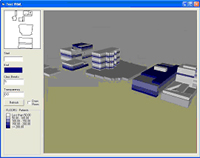Drs. Stefan Sardqvist and Stefan Svensson of the Swedish Rescue Service Agency recently completed a series of fire tests studying large-scale fire fighting, and the differences between manually applied high-pressure and low-pressure firefighting systems and the effect of heat stress on fire fighters. The complete study is discussed in their paper, “Fire Tests in a Large Hall, Using Manually Applied High- and Low-Pressure Water Sprays”, published in Fire Science & Technology, Vol. 21, No. 1, pp. 1-17, 2001.
The purpose of the tests was to investigate the capacity of the fire service to fight fires in large spaces; to obtain data to quantify the capacity; to compare a high-pressure to a low pressure fire fighting system; and to measure the heat stress on fire fighters using breathing apparatus equipment during a fire attack.
The tests provided a lot of data that also may be used for further studies. As anticipated, the capability of the firefighter to extinguish fires in large spaces relies on the ability to reach the burning area of the fuel. When both surface cooling and gas phase effects are considered, the high
pressure system requires only approximately two-thirds of the water required by the low-pressure system to achieve the same extinction capacity in this scenario.
During fire fighting, firefighters experienced an increased pulse rate that appeared to be triggered by mental stress and increased due to increasing skin temperature. Tests with and without cooling vests to vary heat stress showed that under low workload, heat stress and heat penetration through protective clothing may produce dangerous fire fighting conditions, even after a few minutes.
For additional information, contact Dr. Stefan Sardqvist, telephone: (46) + 46 23 36 44, e-mail: stefan.sardqvist@srv.se or Dr. Stefan Svensson, telephone: (46) + 46 23 35 76, e-mail: stefan.svensson@srv.se.

Pallet arrangement for manual fire suppression test. The front row of pallets was sufficient to prevent water from reaching the row of pallets behind.
DoD Technology Can Help Visualize Fire Ground Information
Imagine the Incident Commander (IC), or those assisting the IC, being able to view all of the important information about involved structures and the surrounding neighborhood by using a laptop based intelligent map for display of pre-incident plans and exposures. The intelligent map could be queried to see water sources, cut-offs, population densities and building systems information. From the map the fire flows are calculated, distances measured and map icons placed for the responding apparatus and personnel. Finally, area plan views can be switched to a three-dimensional view of the fire ground with the ability to see and mark occupant locations, sensors, imbedded floor plans and population by floor.
Jim Howard, president of DESC, Inc, believes all this is possible today by taking advantage of current Department of Defense (DoD) technologies and transferring them to the first responders/public safety arena. In addition, by assembling various pieces of the DoD efforts and modifying it for the fire services, fireground accountability could become attainable. The DoD equips combat vehicles with this type of capability for enhanced electronic situational awareness. Pursuing this vision, with research funding from the Defense Threat Reduction Agency, and a grant from the Oklahoma City Institute for the Prevention of Terrorism, DESC, Inc., (www.descinc.com) has been adapting DoD software technology for use by the fire service.
This development is proceeding, keeping in mind that effective software tools for the fire service must be scalable from a house fire to a major terrorist attack or natural disaster. It needs to be interoperable with the major Geographic Information Systems (GIS), Computer Aided Design (CAD) and major office productivity software that are affordable and in used by the fire service. Situational awareness or spatial awareness of emergency events should be enhanced through the software visualization in both 2D and 3D. Lastly, for interoperability and future support needs, there should be other products available that use the same core technologies.
For additional information, contact Jim Howard at (1) + 405-330-9212 or jhoward@descinc.com.

Population density of neighborhood by floor.

Building occupants and embedded floor plan.